April is finally here. In April, things pick up rather quickly in Pennsylvania. It is in April that breeding begins for many birds, and that the first mushrooms begin to poke from the soil. Leaves are going into bud, birds are courting their mates, daffodils are in bloom and trout season is only 12 days away!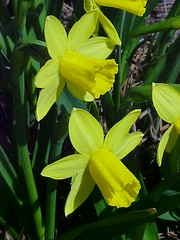
Spells of warm weather have really brought life back to Pennsylvania's natural world. Wood frogs and spring peepers (also a frog)have united in a chorus along the marshy stream that runs along Tuskovich Lane. Balls of jelly-like eggs lay in the pools as tadpoles develope. Massive flocks of turkey vultures soar on warm air thermals that rise from the warming valleys, while red-tailed hawks scream loudly declaring their right to a mate. I jump an American Woodcock just about every day, and I can hear their nasal "peeeeeeeeent" cry at night in swampy forested areas.
My father and I opted to take a hike. Although our primary objective for heading to Owl Hollow was to find shed deer antlers - I of course brought the digital camera along to take pictures of anything that caught my eye. I spent more time looking at dead mushroom remains and new forest growth than for deer antlers.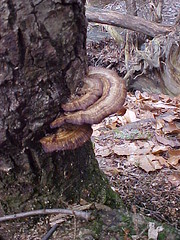
We hiked up through a ravine, and underneath the bough of a group of pines. We knew a very large buck that had frequented this part of owl hollow and were scanning for his shed antlers when I came across a large oak stump. Dead stumps do much for the forest. Animals use them as lookouts and food storage, young seedlings and moss sprout from them, and in the case of some - fungi appear to help decay the wood.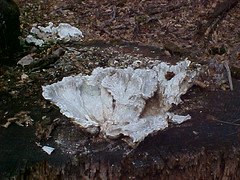
Chicken of the Woods, in it's white, "dead", inedible, moldy form. This is only the fruiting body. Beneath the stump surface lives the actual organism; the mycelium, who will fruit again when the time is right.
Preserved well over the winter, I had no idea of just how many chicken mushrooms were growing in owl hollow. Before I had a car, my only visits were while hunting with my father - so during the "season" for this delicious mushroom, I was obviously absent and unable to scout the area for mushrooms. Oh boy did I ever miss out!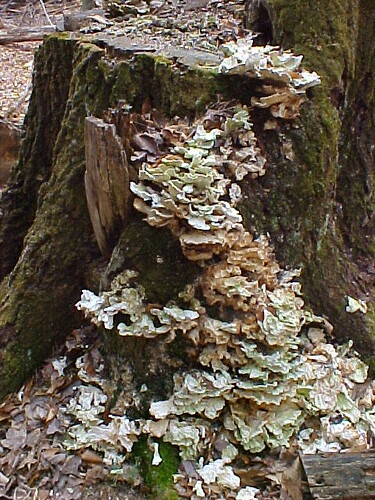
Though I was disgruntled by my findings, they will likely re-grow in the same spot come August, and I will be hauling them out of Owl Hollow by the pounds! I don't want to wish my life away though, so let's focus on the now!
Dad and I also noted strange droppings - like that of a giant rodent. They littered the entrance of den dug by the mysterious creature - when suddenly I remembered the porcupine! This was his home. My father had seen him frequently back in December during the antlered deer season.
Due to "quality deer management", the seedlings of Owl Hollows trees finally have a fighting chance of growing without being devoured first. I noted many different seedling sprouts throughout our hike - including hemlock sprouts. Many of the hemlock sprouts found were growing on dead logs of the same species. Another example of how death can create life, for future generations. Due to high moisture, many of the logs also hosted moss, and some were engulfed in a coating of red soldier lichen.
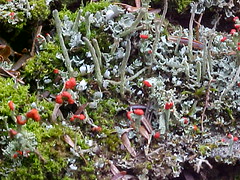
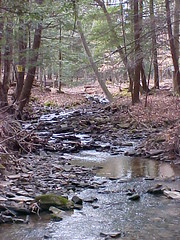
Owl Hollow Creek was running pretty high, as is typical for the year. By mid-summer it will be but a mere trickle with stagnant pools. Despite this, there is always enough of a flow to keep creek life thriving. But again, there is balance here. While the pools of water make the stream life susceptable to attack from herons and other predators - the insects who breed create an important summer food source for the very same stream life who's life drought threatens.
Adding some bursts of color to the forest floor were the colt's foot - typical for this time of year. Appearing at a glance to be some sort of dandilion, colt's foot is actually a much more beautiful plant.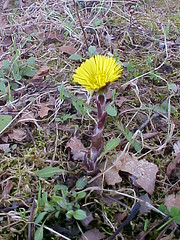
I've been seeing a lot of these growing along the roads, growing up the bank, and even in stoney driveways. Relatively short seasoned, it is one of Pennsylvania's first spring flowers (along with crocus) and gives us something interesting to look at and talk about in the otherwise drab early-spring woods.
Monday, April 02, 2007
April and a Journey to Owl Hollow
Posted by
Michael
at
10:48 PM
![]()
Subscribe to:
Comment Feed (RSS)




|